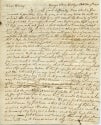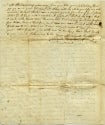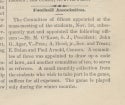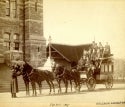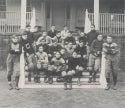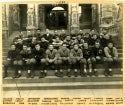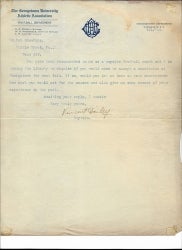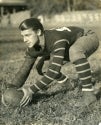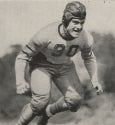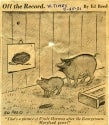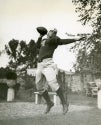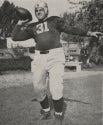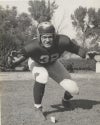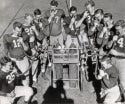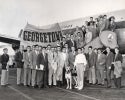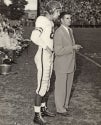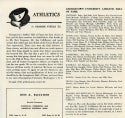A History of Football on the Hilltop from 1830–1951
There Goes Old Georgetown
Letter from student John Carroll Brent, October 18, 1830
A form of football was played by Georgetown students as early the 1830s.This letter contains the earliest known reference to the sport on campus (see six lines from the bottom of the page):
. . . We play football at present, what I mean by football is that it is a kind of leather bag in which is placed a bladder filled with air which causes it to bounce up very high and is kicked about by the boys. I have had my feet skinned and bruised by it very often. I am lame with one I have received today . . .
John Carroll Brent was born in Washington on July 25, 1814. Georgetown’s founder, John Carroll, was his great-uncle. Brent enrolled at Georgetown in 1830, and graduated in 1833. In addition to his pioneering football efforts, he was a charter member of the Philodemic Society.
Diary of Georgetown prefect Charles Stonestreet, S.J., 1839-1843. (Maryland Province Archives, box 13, folder 6)
The entry for for September 25, 1840 reads: Justin McCarthy broke his arm whilst playing foot-ball . . .
Georgetown College Journal, December 1874
The first attempts at organizing football on campus came in 1874. A meeting of students held on November 1 of that year named a committee of 15 to form a football association. This committee elected a president, vice president, secretary-treasurer and two censors. Exactly what a football censor did in 1874, the College Journal does not explain.
The association was to be self-funding: A committee of three was appointed to draw up a code of laws, and another committee of ten was appointed to serve as referees. A small monthly collection from the students who wish to take part in the game will suffice for all expenses.
Football team of 1887
This image which was printed in the December 1898 Georgetown College Journal is the oldest image of a Georgetown football team housed in the University Archives.
The Football Association formed in 1874 seems to have been very short-lived. When students formed an Athletic Association in 1875, its founding documents make no mention of football. And the sport is only sporadically mentioned in the Georgetown College Journal in the early to mid 1880s. However, in 1887 three games were played against external opponents: Emerson Institute of Washington, now Emerson Preparatory School (whom Georgetown defeated 46 to 6); Alexandria High School (who won 24 to 8) and Washington High School (whom Georgetown defeated 12 to 6). The College Journal noted of the Alexandra High School victory that the first half was very exciting, but the superior weight of the opponents and the lack of training of the College team told against Georgetown.
Alphonsus J. Donlon, S.J. (President of Georgetown University 1912-1918). Photograph by Harris & Ewing, Washington, D.C., 1915
The 1887 team photograph includes Al. Donlon, C’1888, (pictured third from the left in the front row). Father Alphonsus Donlon would serve as Georgetown University President between 1912 and 1918. Unsurprisingly, he was a strong advocate of collegiate athletics. Interviewed by The Washington Post upon his appointment as President, he stated that there is one policy . . . which I think our colleges should adopt. That is the custom of developing their teams with amateur coaches. I would see each college team trained by a graduate of that college who can be with the team throughout the season. Professional coaching tends to engender in the team the spirit that ‘the ends justify the means’ and causes the members of the team to lose sight of the true gentlemanly spirit. I believe in playing to win but not with this as the sole object in view.
Football team of 1889
1889, the year that Georgetown celebrated its centennial, marks the beginning of inter-collegiate football competition at Georgetown. The first inter-collegiate opponent was the University of Virginia. The final score according to the Georgetown College Journal was 34 to 0 in favor of Georgetown; sadly, the Journal gives no further account of the game.
Football team on the steps of Healy Hall, pictured before the traditional Thanksgiving football game, November 24, 1892
The gentleman in the top hat is the team manager. Pictured in the middle row, third from the left (number 6), is Tommy Dowd, center fielder for the Washington Senators baseball team who was nicknamed “Buttermilk Tommy.” He was eligible to play football for Georgetown because he was enrolled as a law student. He served as Georgetown’s player-coach in 1891 and 1892 but left in 1893 when he was traded by the Senators to the St. Louis Browns.
“Georgetown 96, Neptune Boat Club 0.” Account of a November 1892 football game in the Georgetown College Journal
The final score of 96 represents the highest total ever earned by a Georgetown football team. Things were difficult for the Neptune Boat Club, a Baltimore team, even before play began as they traveled with only 10 players. A Georgetown reserve played for them to make up the numbers.
Football team of 1893 in front of the grandstand on the athletic field
Included in this image, second from the right in the second row, is Malin Craig who attended Georgetown from 1889 to 1894 and later served as the U.S. Army Chief of Staff from 1935 to 1939.
General Malin Craig, U.S. Army Chief of Staff, pictured on October 7, 1935. Signal Corps photograph
Malin Craig transferred from Georgetown to West Point in 1894. He served in the Spanish-American War, the Philippine-American War, the relief expedition during the Boxer Rebellion, and in War World I when he received the Distinguished Service Medal. He later commanded the Panama Canal Zone, served as President of the Army War College, and succeeded General Douglas MacArthur as the U.S. Army Chief of Staff.
Football fans leaving campus on Thanksgiving Day, 1894
In 1894, the Thanksgiving opponent was the Columbia Athletic Club (C.A.C.) The game was expected to be a close one. Ten thousand people gathered at National Park, home of the Washington Senators baseball team at Georgia Avenue and 5th Street, N.W., to watch. Anticipation grew as the start time approached and the crowd had a festive air. Fish-horns, cow-bells, and every device for making noise known to the small boy at Christmas time and the Fourth of July was forced into service to supplement the refined efforts of lung power to give expression to the pent-up feelings of the excited multitude, according to the Georgetown College Journal, November 1894. The C.A.C. won by a score of 20-0 in what The Washington Post described as the fiercest football game ever played in Washington. Four Georgetown players were carried off the field injured, including captain George Bahen and quarterback Bob Carmody; one CAC player broke his collarbone. At one point, a sideline fight broke out between the substitutes for both teams.
Letter from Columbia Athletic Club President Alexander Grant to Georgetown President J. Havens Richards, S.J., December 4, 1894
I desire to express formally and on behalf of the Columbian Athletic Club the deep regret we feel at the unfortunate accident which occurred on the foot ball field last Thursday by which one of the members of your team - George Bahen - was so seriously injured. We have all watched with deepest anxiety the progress of the last and with sorrow noted the extremely critical conditions that have developed . . .
Program from the Law Department benefit for George Bahen, March 7, 1895
George Daniel Bahen, known as “Shorty” on account of his 175 pound/5 foot 4 inch frame, was the most seriously injured player in the 1894 Thanksgiving game. Medical assessment after the game suggested that his spinal injury would result in permanent paralysis, assuming he lived. His family kept a constant vigil at his bedside. Friends from Georgetown College visited as did, to their credit, every member of the C.A.C. team after they had been assured by Bahen’s brother than he bore them no ill-will.
A benefit organized by the Law Department was held to raise money to cover Bahen’s medical costs. Nineteen days later he died. A memorial to him made of Virginia blue granite stands in Mount Calvary Cemetery, close to the James River, in his hometown of Richmond, Virginia. It bears the following inscription: George D. Bahen, born Jan. 12, 1874, died on the 26th of March, 1895, at Washington, D.C., from injuries sustained on Thanksgiving Day, 1894, in heroically upholding the Blue and Gray of Georgetown, on the field of athletics.
“Will Play no Football. Georgetown University puts an End to This Sport.” The Washington Post, September 11, 1895
The Post attributed many of the injuries in the 1894 Thanksgiving game to the hardness of the ground; Georgetown supporters thought otherwise and the Georgetown student body passed a resolution the following day stating that, in view of the methods employed by the C.A.C. in the game, no member of the Georgetown Athletic Association would compete in any athletic contest with representatives of the Club. A later decision by University President J. Havens Richards, S.J., reported in the article above, went further and suspended all football. Georgetown students did not field a football team again until 1897 when intramural play resumed. Varsity play restarted in 1898.
Team of 1898
With no returning players, the Georgetown team struggled throughout the 1898 season. However, they did record a victory over their old rivals Virginia, albeit in a forfeit after the Virginia team left the field in protest over a disputed call.
Andrew “Cy" Cummings, pictured with Georgetown University President Arthur A. O’Leary, S.J. at the Georgetown v. Maryland game, November 1935
One game that Georgetown did win outright during the 1898 season was played against Columbian College (now George Washington University) on November 24. The final score was 12 to 5 in favor of Georgetown. One of the better players for the Colonials in that gamewas their right guard, Andrew Cummings, who transferred to Georgetown and played on our team the following year. Known as “Big Cy”, he served several terms in the Maryland legislature after graduation. He later became president of the Laurel Race Track.
Poster for Georgetown-University of Virginia game, Saturday, November 18 [1899]
Team of 1900
Included in this shot (front row, second from the left, holding the ball) is Arthur Devlin, a superb all-round athlete who played fullback and was captain of the 1900 team. After leaving Georgetown, he played third base for the New York Giants and was part of the team when it won the 1905 World Series.
Varsity Squad, 1905
On November 30, 1905, Georgetown played the Carlisle Indian Industrial School at National Park in front of an audience of more than 5000. The result was a Carlisle victory, 76 to 0, which still stands as the highest score run up against a Georgetown football team. Albert Exendine, who would coach the Hoya squad between 1914 and 1922, played right tackle for Carlisle in this game.
Part of a football uniform, ca. 1905
This is made out of heavy canvas with light pads sewn into the thigh region.
Georgetown v. Virginia, November 10, 1906
Note the grid pattern which can clearly be seen on the field. Until the early 1920s, football fields were frequently painted with a checkerboard pattern resembling a gridiron (a metal grid used for cooking over a fire.) Before Copley and White-Gravenor were built in the 1930s, the main campus athletic field was on what is now Copley Lawn.
Thanksgiving game football, November 29th 1906. - Georgetown 16, George Washington 6
Team of 1909
Included in the group (front row second from the left), is quarterback Harry Clifton "Curley" Byrd, an early user of the newly legalized forward pass. Byrd, who attended Georgetown’s Law School from 1909 to 1910, would serve as University of Maryland President from 1936 to 1954. The outdoor athletic stadium on Maryland's campus was formerly named for him. His name was removed by the University’s Board of Regents in 2015 because of Byrd’s opposition to integration.
Letter from H.C. Byrd to Georgetown President Arthur A. O’Leary, S.J., November 23, 1936
This was written after Georgetown defeated the University of Maryland by a score of 7 to 6
. . . I just could not help remembering the time when I, myself, wore one of those gray jerseys and from that memory took a very real pride in the dogged persistence of your players that finally achieved for them a great victory . . .
Printed card from the family of Archer Christian, November 14, 1909
As the handwritten note at the bottom of this card explains, Archer Christian, fullback for the University of Virginia team, died at the Georgetown University Hospital following injuries sustained in a game played at Georgetown in November 1909.
Letter from University of Virginia President Edwin Anderson Alderman to Georgetown President Joseph Himmell, S.J. about Georgetown’s reaction to Archer Christian’s death, November 18, 1909
. . . I have the impulse to write a more intimate word expressive of my very great personal appreciation of the extremely generous, sympathetic, and thoughtful conduct of the faculty and students of Georgetown to this University during these days of suffering and loss . . .
Telegram to Georgetown University President Joseph Himmel, S.J., November 18, 1909
Georgetown again suspended football after Archer Christian’s death. This decision was met with approval by some, as this telegram sent by “a mother of boys” to Fr. Himmel attests.
“The New Football Rules.” Clipping from an unidentified newspaper, 1910
This report ties changes in the rules of football, including the abolition of the flying tackle and the division of the game into quarters rather than halves, to the 1909 death of Archer Christian at Georgetown. Georgetown resumed football in 1910, apparently satisfied that the rule changes made the game safer.
Coach Fred K. Nielsen pictured in an unidentified newspaper article, 1910
Nielsen was born in Denmark and emigrated to Nebraska with his parents as a young child. He coached at Georgetown for the 1910 and 1911 seasons, having graduated from our Law School in 1907 with a Master of Laws degree, and amassed a 14-2-2 record. In 1913, he was named as the Assistant Solicitor of the Department of State and he represented the United States at the 1919 Paris Peace Conference.
Georgetown football poster by Marguerite Neale. Published by United States Poster Company, Washington, D.C., 1910
Women students at Georgetown did not begin participating in organized sports until 1952, when the Women’s Athletic Association was established by a group of Nursing students. However, images of women were used in sports promotion at a much earlier date as this poster illustrates.
Souvenir program from the Georgetown v. Virginia game played at Georgetown, November 12, 1910
This is the earliest football program found in the Georgetown University Archives.
Letter from Georgetown football captain Vincent Daley to Bob Shiring, asking if he would be interested in coaching the team, 1910
In the years just prior to this letter, Shiring had a prominent career as a pro player (pre-NFL) on the best teams in Pittsburgh (Homestead) and The Massillon Tigers in the Ohio League. He was referred to in at least one newspaper as the “world’s greatest center,” and played on the “world champion” team every year from 1901-1910. Family lore has it that Shiring passed on the Georgetown coaching position since the University asked for a college degree and he did not have one, having left school after 8th grade to work and help support his family.
Scan and caption information courtesy of Gregg Ficery, B'88 and great-grandson of Bob Shiring
Georgetown and University of Virginia mascots meet on Georgetown’s athletic field before the November 18, 1911 game. Photograph courtesy of the University of Virginia Library
Harry Costello, L'1913. Pictured in Ye Domesday Booke, 1914
Harry Costello, known to his classmates as “Nine Point Harry” was the Georgetown quarterback for three seasons, despite weighing only 138 lbs and standing only 5 feet 7 inches tall. In addition to his passing abilities, he was an outstanding drop kicker and punter. Legendary coach Glenn A. “Pop” Warner noted of him that "for his inches, he was one of the greatest players that ever lived" and he is considered by many as Georgetown’s greatest football player.
Costello was also known for his ability to tell stories about his playing days and subsequent career as a coach and reporter. One of his favorites involved him waking up in the Mayflower Hotel and discovering Senator Huey Long of Louisiana in the neighboring twin bed. They bore a physical resemblance to one another and the taxi driver who picked Costello up at the Occidental Restaurant after a night of drinking mistook his passenger for Long and delivered him to the Mayflower. After introductions, Costello used hotel chairs to demonstrate various football offensive and defensive formations to Long. The Senator was so impressed that he later had Costello appointed director of publicity for the Athletics Department at Louisiana State University.
Remarks by Harry Costello on Kehoe Field, November 4, 1967
On November 4, 1967, Georgetown celebrated Harry Costello Day. At halftime in the Georgetown-St. Peter’s game, Costello was honored with a plaque and a lifetime membership in the Student Athletic Association.
Thomas F. Gormley, L’1916
In a hard-fought game against Army in October 1915, right tackle Tom Gormley, in a move that garnered national attention, allegedly bit the arm of the Army center and was ejected from the game. The officials while admitting that there was not an explicit rule against biting decided, after conferring on the field, that it did constitute unnecessary roughness. Army requested after the game that Gormley be dropped from the Georgetown team. Georgetown promised an investigation but did not conduct one after discovering that Gormley’s collegiate football career dated back to 1910 when he played at Villanova. He had also played for Catholic University before transferring to Georgetown. Georgetown’s athletic administration ruled that six years of collegiate football was too much for any player and asked Gormley to sit out the remainder of the 1915 schedule.
Gormley always denied the biting allegation. In 1947, he recollected that: The biting incident never happened. I was put out of the game for clipping. McEwan [the Army center] was running around squealing to the referee that someone had bitten him. I was feeling mean, so I said to him half-jokingly: “I did it. What the hell are you going to do about it?” He was inducted into the Georgetown Athletic Hall of Fame in 1954 alongside Harry Costello.
Account of the Georgetown-Army game played at Westpoint on October 24, 1916. From the Georgetown College Journal, November 1916
“Gilroy Making 60 Yard Run. Georgetown v. Dartmouth.” Ye Domesday Booke, 1919
Known as “The Great Gilroy,” halfback John held school records for career scoring, touchdowns, and points after touchdown. In one game, played against Albright in 1916, he scored 47 points (six touchdowns and 11 PATs) in an 80 to 0 Georgetown victory. He graduated from Georgetown’s Dental School in 1919. In 1920, when the American Professional Football Association (later renamed the National Football League) was formed, Gilroy was signed by Jim Thorpe, the player-coach for the APFA Canton Bulldogs. Thorpe also signed former Georgetown players Arthur “Bunny” Corcoran, Larry Green, Dan O’Connor, and Tommy Whelan. In all, at least 50 Georgetown players have gone on to careers in the NFL.
Poster for Thanksgiving Day Benefit. The Champions of the Enlisted Service, Ambulance vs. Champions of South Atlantic, Georgetown. Proceeds to Help Ambulance Selection Fund. American League Park, Washington, Thursday November 29 [1917]
Letter from Louis C. Haggerty, C’1912, to Georgetown President John B. Creeden, S.J., dated November 12, 1920, reporting a resolution passed at the annual meeting of the New York Alumni emphasizing the importance of athletics to Georgetown's reputation an
Coach Al Exendine. Pictured in Ye Domesday Booke, 1916
Albert Andrew "Al" Exendine played college football under Pop Warner at the Carlisle Indian Industrial School where he was an All-American. He was an assistant coach when Carlisle resoundingly beat Georgetown 34 to 0 on November 1, 1913 game. Pop Warner, as a favor to his friend “Bunny” Larkin (Dr. Edward Larkin, half-back on the 1904 Georgetown Squad and now team surgeon for the Washington Senators baseball team and part-time Georgetown backfield coach), left Exendine in Washington to help with the Georgetown team.
Exendine was Georgetown's head football coach from 1914 to 1922. In 1916, his Georgetown team outscored its opponents 474 points to 33. After leaving Georgetown he coached at a number of schools including Washington State University and Oklahoma State University. He earned a law degree at Dickinson School of Law while coaching at Georgetown and later practiced law in Oklahoma and served with the Bureau of Indian Affairs. Exendine was inducted into the Georgetown Athletic Hall of Fame in 1953 and the College Football Hall of Fame as a player in 1970.
Lou Little named as new Georgetown Football Head Coach, The Hoya, March 13, 1924
Following a dismal 1923 season, Georgetown hired Luigi Piccolo, better known to the world as Lou Little, as head football coach and Director of Athletics. Little was a standout star for the University of Pennsylvania and spent time in the professional league as captain and coach of the Frankford Yellow Jackets. By his second year on the job at Georgetown, Little had turned the Hoyas into the winning team that fans and alumni expected, taking them from a 3-6 record to an 8-1 record. During his tenure, Little instituted the first out of town training camp and preseason conditioning and practice for the Hoyas. He also aided in the establishment of a homecoming game, with the first one taking place in 1925. In his 6 years on the hilltop, Little accumulated a record of 41-12-3.
Little left Georgetown after the 1929 season to be the head coach at Columbia University, a position he held until 1956. He was inducted into the Georgetown Athletic Hall of Fame with the inaugural class in 1954 and the College Football Hall of Fame in 1960.
The Hoyas in action against the University of Pennsylvania in 1924, Ye Domesday Booke, 1925
In one of the more thrilling games of the 1924 season, an outmatched Hoya team held the formidable University of Pennsylvania squad to only 3 points, losing the game by a score of 3-0. Despite the loss, the Hoyas gave the Quakers, and over 30 thousand fans in attendance in Philadelphia, their biggest scare of the season.
Harry “Babe” Connaughton, Tackle 1924-1926
At 6 foot 2 inches and 275 pound, Connaughton was far and away the biggest player on the Georgetown squad. His stellar play during the 1926 season earned him honors as a consensus All-American. Connaughton would go on to play professional football with the Frankford Yellow Jackets. He was inducted into the Georgetown Athletic Hall of Fame with the inaugural class in 1954.
Tony Plansky, Fullback 1922-1925
Plansky, also a star decathlete, would go on to play for the New York Giants and the Boston Braves. He was inducted into the Georgetown Athletic Hall of Fame with the inaugural class in 1954.
Claude Grigsby, Center 1925-1927
Grigsby served as team captain during the 1927 season. He was inducted into the Georgetown Athletic Hall of Fame with the inaugural class in 1954.
Letter acknowledging Georgetown’s membership in the NCAA, January 4, 1926
In 1906 the Intercollegiate Athletic Association of the United States was established with 62 charter members. The group would change its name to the National Collegiate Athletic Association in 1910. Georgetown was elected as a member in 1926.
Georgetown Football Team and Schedule, 1927
Arguably one of Little’s best teams while at Georgetown, the Hoyas of 1927 put up a record of 8-1 and scored a combined total of 377 points to their opponents’ 19 points. Only Syracuse was able to break the goal line all season and handed Georgetown their only loss of the season.
Letter from Referee Victor Schwartz to Georgetown President Charles W. Lyons, S.J., November 8, 1927
In his letter, Schwartz complements the sportsmanship of the Georgetown Football Team and Coach Lou Little.
“Georgetown Shrinks Violets 7-2”, The Hoya, November 3, 1928
With men outweighing the Hoyas by an average of over 20 pounds, NYU was heavily favored to win. Led by the strong play of Jim Mooney and Ken Provincial, the Hoyas pulled an upset victory in front of 50,000 fans at Yankee Stadium, the largest attendance recorded for a Georgetown away game.
Jim Mooney, Tackle and Punter 1926-1929
Mooney is considered to be Georgetown’s greatest punter. In the win over Mount St. Mary’s in 1929, Mooney averaged over 60 yards a kick. He served as captain of the 1929 team as was inducted into the Georgetown Athletic Hall of Fame with the inaugural class in 1954.
Maurice “Mush” Dubofsky, Guard 1929-1931, Line Coach 1933-1948, Head Coach 1968-1969
Dubofsky spent a brief period with the New York Giants in 1932 but returned to Georgetown at the request of Head Coach Jack Hagerty to serve as line coach, a position he would hold until 1948. He would later return as head football coach in 1968. Dubofsky was inducted into the Georgetown Athletic Hall of Fame with the inaugural class in 1954.
Everybody’s Football by Maurice Dubofsky and Francis Stann with forward by Lou Little, 1947
Dubofsky and Stann, sports columnist for the Washington Evening Star, produced the book with the intention of simplifying the game of football for fans, spectators, and those wanting to learn the game. This copy is signed by Dubofsky and was presented to Georgetown President Lawrence Gorman, S.J.
“Tommy Mills Resigns; Jack Hagerty to Coach Hoyas”, Washington Herald, October 31, 1932
Tommy Mills, who was hired away from Notre Dame by Georgetown following the departure of Lou Little, couldn't manage to get the successful Notre Dame system to work at Georgetown and he resigned mid-way through the 1932 season. Georgetown then turned to Jack Hagerty, a former standout running back for the Hoyas from 1923-1925, to get the team back into winning form. He immediately dumped the Notre Dame system in favor of the single shift and hired two young and capable assistant coaches, Maurice Dubofsky and George Murtagh, both former Georgetown stars. While the remainder of the 1932 season was spent adjusting to Hagerty’s new system, the team did manage to score a moral victory by battling a tough Bucknell team to a 6-6 tie.
Coach Hagerty and team members review plays, 1932
Hagerty compiled a record of 61-42-10 during his 14 years as head coach. He led the Hoyas to a 23-game undefeated streak from 1938-1940 that culminated with an Orange Bowl bid in 1941. He resigned as head coach in 1948 and became Georgetown’s Athletic Director, a post he held until 1969. Hagerty was inducted into the Georgetown Athletic Hall of Fame with the inaugural class in 1954.
“Georgetown Ties Bucknell 6-6”, The Hoya, November 23, 1932
The game against Bucknell proved to be the highlight of a very dismal season. Buoyed by the play of captain Ray Hudson and fullback Wilmer Bradley, the Hoyas eked out a tie against a tough Bison team.
Maryland defeats Georgetown 6-0, Ye Domesday Booke, 1935
The game, part of the 1934 season, was the first meeting between the two teams in 27 years. The only score came from an interception in the first quarter of play.
Clem Stralka, Tackle 1935-1937
Stralka, who was often referred to as “Little Bull”, would go on to play for the Washington Redskins following graduation. He was inducted into the Georgetown Athletic Hall of Fame with the inaugural class in 1954.
Football cartoon following the Georgetown vs Maryland game, Washington Times, 1936
Georgetown won a close 7-6 game against the Terrapins. Following the game, former Georgetown football star and current President at the University of Maryland, H.C. “Curly” Byrd, wrote a letter to Georgetown President Arthur O’Leary, S.J. to congratulate him on the victory and to reminisce on his own time at Georgetown. This letter is on display with the material dated 1909.
Quarterback Tom Keating in action against Manhattan, 1936
The Jaspers broke a 2-year losing streak and blanked Georgetown by a score of 13-0.
The Hoyas in action against Shenandoah in 1937, Ye Domesday Booke, 1938
Georgetown scored five touchdowns in the final quarter to take the win by a score of 38-0.
“Hoyas Back Coach, Despite Ruin Caused by Redskin Scrimmage”, 1937
Coming off of a successful 1936 season with a record of 7-2, the Hoyas surprised many with a lackluster 1937 season of 2-4-2. One of the contributing factors may have been that the Hoyas lost three key players to injury in a scrimmage with the relatively new Washington Redskins of the National Football League.
Georgetown Football Team and Schedule, 1938
The 1938 season would see the start of a 23-game undefeated streak. The Hoyas would score a combined total of 185 points to their opponents’ 26 points.
Jim Castiglia dives over the Hampden-Sydney defense in the Hoya’s first win of the 1938 season, Ye Domesday Booke, 1939
“Georgetown Rally Ties Orange, 13-13, Syracuse Herald American, October 15, 1939
Syracuse tested the Hoya’s 10-game undefeated streak but could only come away with a tie thanks to the last-minute heroics of Lou Ghecas, who ran 70 yards for a score that would tie the game.
Joe Mellendick, Halfback 1937-1938
Mellendick’s fine play in the 1938 season earned him an All-American Honorable Mention and selection to the All-District first team. His football career would be short-lived, though. An injury during the 1938 Maryland game forced Mellendick to retire from football. He would go on to find success as a professional baseball player with the Washington Senators and the Baltimore Orioles. He was inducted into the Georgetown Athletic Hall of Fame in 1975.
Jules Koshlap, Halfback 1938-1941
Koshlap, along with Jim Castiglia, Lou Ghecas, and Joe McFadden, formed the crux of the Hoya backfield that helped the team win 23 straight games from 1938-1940. Koshlap, who was ambidextrous, had a talent for confusing other teams by throwing the ball with either hand. He went on to play professional football with the Pittsburgh Steelers and was inducted into the Georgetown Athletic Hall of Fame in 1982.
Lou Ghecas, Halfback 1938-1941
Ghecas’s offensive heroics were a huge contributing factor to Georgetown’s 23-game undefeated streak from 1938-1940, where he was one of the leading scorers for the Hoyas year after year. Ghecas was also a standout star on the baseball team and spent some time in the minor league with the New York Yankees organization. He briefly played professional football for the Philadelphia Eagles in 1941. Ghecas was inducted into the Georgetown Athletic Hall of Fame in 1982.
Georgetown takes on Boston College in a battle of undefeated teams, 1940
Riding a 23-game winning streak, the Hoyas confidently strolled into Boston to take on the undefeated Eagles. Georgetown played a close game up until the final minutes but their efforts were not enough to overcome the play of Boston College’s Charley O’Rourke and the Hoyas lost a heartbreaker by a score of 19-18. Sportswriting legend Grantland Rice named this game one of the greatest sporting events of the century. Despite the loss, Georgetown finished the regular season with a record of 8-1 and scored a bid to the 1941 Orange Bowl. For more on Georgetown’s Orange Bowl appearance, check out the spotlight case.
The items on display document just a small fraction of the media that was generated in the lead up to, as well as the aftermath, of the game.
Jim Castiglia, Fullback 1938-1941
Castiglia’s play during the 1938 season earned him a selection on the All District first team. Following graduation, Castiglia played professionally with Philadelphia and in 1947 he would be reunited with GU teammate Augie Lio when both men played for the Baltimore Colts. He would also go on to play professional baseball with the Philadelphia Athletics. Castiglia was inducted into the Georgetown Athletic Hall of Fame with the inaugural class in 1954.
Georgetown Team members celebrate victory over NYU, 1939
Georgetown beat the Violets by a score of 14-0. Pictured from left to right are Mike Kopcik, end coach George Murtagh, Al Blozis, Myron Damohray, Earl Wixted, and Frank Meglen.
Al Blozis, Tackle 1939-1941
At 6 foot 6 and 250 pounds, Blozis was the biggest player Georgetown had seen since Harry Connaughton in 1926. In addition to his football talents, Blozis was an accomplished track and field athlete, winning three consecutive NCAA shot put titles and, for a time, held the indoor shot put world record. He was drafted by the New York Giants after graduation and played for them for two seasons before enlisting in the Army. At Fort Benning, he set the Army’s hand grenade throwing record at 94 yards 2 feet and 6.5 inches. Blozis was inducted into the Georgetown Athletic Hall of Fame with the inaugural class in 1954, the College Football Hall of Fame in 1986, and the USA Track and Field Hall of Fame in 2015.
Augie Lio, Right Guard and Kicker, 1938-1941
After a stellar career at Georgetown, including a first-team All-American selection in 1940, Lio would be drafted by Detroit after graduation. He would also spend time playing with the Boston Yanks, the Philadelphia Eagles, and the Baltimore Colts. He was inducted into the Georgetown Athletic Hall of Fame with the inaugural class in 1954 and the College Football Hall of Fame in 1979.
Elmer Oberto and Joe Gyorgydeak work to take down their foe, Ye Domesday Booke, 1943
The Hoyas fought Alabama Polytechnic Institute to a 6-6 tie thanks to strong defensive play, including a stop at the 4 yard line in the closing quarter of the game.
Georgetown linemen and backs of the 1942 season, Ye Domesday Booke, 1943
The Hoyas started the 1942 season having to contend with losing many of their big stars from 1941 like Lio, Blozis and Gehcas. The 1942 squad would rise to the challenge. Thanks to the play of Ed Agnew, Joe Gyorgydeak, Frank Dornfeld,Bill McLaughlin, and John Barrett, the Hoyas ended the season with a record of 6-3. Due to World War II, this would be the last team fielded by Georgetown until 1946.
List of former Georgetown football players who died in service of their country during World War II, The Georgetown Hoyas by Morris A. Beale, 1947
Listed here are Edward Agnew, John Barrett, Jr., Al Blozis, Robert Duffey, Albert Vaccaro, Francis Daly, William Nealon, Robert Sullivan, James Gallagher, Jim Mooney, Henry Gibbins, Herbert Stadler, and Malin Craig
Georgetown battles Wake Forest at Griffith Stadium, October 4, 1946
The Demon Deacons recorded a 19-6 win over the Hoyas.
Georgetown players test out new oxygen dispensing cart, 1946
The Hoyas debuted the new machine at their game against Wake Forest on October 4, 1946.
Georgetown students kidnap the Fordham Ram, October 10, 1947
Four Georgetown Students traveled to New York with a trailer attached to their car and absconded with the Rameses the Ram under cover of darkness. The ram was put on display in Gaston Hall the night before the game. The Hoyas won the game, played at Griffith Stadium, by a score of 8-7.
“Georgetown Squelches Hurricane, 12-0”, Tulsa World, October 19, 1947
Georgetown entered the game as 20 point underdogs and came away with the upset win in front of 10,000 Tulsa fans. Quarterback Elmer Raba connected with George Benigni and Johnny Kivus to give records the only scores the Hoyas would need for victory. Upon arriving back in D.C., the team was greeted by over 300 classmates who escorted the victors back to campus with an elaborate procession.
Members of the 1949 Georgetown Football Team with mascot Butch, 1949
The Hoyas pose for a photo en route to a game against Tulsa with their loyal mascot, Butch, who served from 1943-1950. Butch, a Great Dane, was originally the mascot for the men in the Army Specialized Training Program at Georgetown. He was adopted by the College after his owner, Captain Andrew D. Gruber, was sent overseas. Butch quickly became a hit on campus and was known to be a sociable dog who attended a wide variety of campus events.
Bob Margarita with Dick Losh, 1949
Margarita coached the Hoyas for two seasons from 1949-1950, compiling a record of 7-12-0. A former all-american at Brown and halfback with the Chicago Bears, Margarita brought his first Hoya team to the Sun Bowl in 1950, a game they lost by a score of 33-20.
Georgetown Football Team, 1950, Ye Domesday Booke, 1951
The Hoyas finished the season with a disappointing record of 2-7. In 1951, University Administrators made the decision to cancel intercollegiate football at Georgetown. While intramural squads would continue to play, Georgetown wouldn’t field another intercollegiate team until 1963.
Letter confirming Georgetown’s agreement to participate in the 1950 Sun Bowl against the Texas Western Miners, November 17, 1949
Letter to Dr. Ruby from Father Guthrie regarding the decision to cancel intercollegiate football, The Hoya, April 11, 1951
In his letter to Georgetown Alumni Association Executive Secretary James Ruby, University President Hunter Guthrie, S.J. outlined the reasons why Georgetown decided to drop intercollegiate football. Those reasons were chiefly financial as the University had been losing an estimated $100,000 on football each year since 1937. Guthrie also pointed to an uncertain outlook in student enrollment and a decline in attendance at games as further proof that the University would only continue to lose money by supporting a team.
The Orange Bowl
Georgetown goes to the Orange Bowl, 1941
Georgetown played Mississippi State in Burdine Stadium (later the Orange Bowl) on January 1, 1941. The Georgetown team left campus on December 25 after Christmas Dinner and arrived in Miami the next afternoon. They stayed at The Flamingo hotel in Miami Beach until January 4, 1941. During their stay, they attended daily mass at St. Patrick Catholic Church, including on the day of the Orange Bowl game. Depleted by injuries, the Hoya lost to the Mississippi State Maroons, 14 to 7, in front of an audience of 29,554.
St. Patrick Church, Miami Beach, January 1, 1941
Pictured are Father Richard Law, S.J., acting Athletic Director and Prefect of Discipline, and team members Joseph McFadden and Marc “Mush” Ostinato.
Curated by University Archivist Lynn Conway and Assistant University Archivist Ann Galloway

